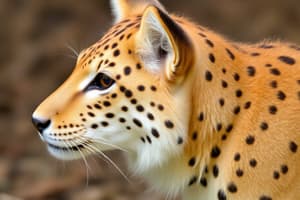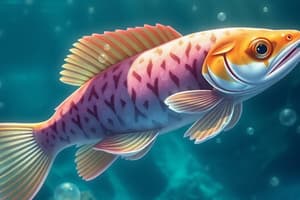Podcast
Questions and Answers
What is the primary function of a camel's adaptation to store water in its bloodstream and tissues?
What is the primary function of a camel's adaptation to store water in its bloodstream and tissues?
- To enhance its communication skills
- To increase its muscle mass
- To regulate its body temperature
- To conserve water in arid environments (correct)
Which of the following is NOT an example of a physiological adaptation?
Which of the following is NOT an example of a physiological adaptation?
- Birds migrating to find food (correct)
- Penguins having a layer of fat to keep warm
- Desert plants having deep roots to access groundwater
- Camels storing water in their bloodstream
What is the primary function of hibernation as a behavioral adaptation?
What is the primary function of hibernation as a behavioral adaptation?
- To enhance an animal's sense of smell
- To conserve energy during periods of food scarcity or harsh weather (correct)
- To increase an animal's speed and agility
- To communicate with other animals
Which of the following is an example of a behavioral adaptation that involves communication?
Which of the following is an example of a behavioral adaptation that involves communication?
What is the primary function of social behavior as a behavioral adaptation?
What is the primary function of social behavior as a behavioral adaptation?
How do adaptations, such as physiological and behavioral adaptations, evolve over time?
How do adaptations, such as physiological and behavioral adaptations, evolve over time?
Flashcards are hidden until you start studying
Study Notes
Adaptations
Adaptations are traits or characteristics that help an organism survive and reproduce in its environment.
Physiological Adaptations
Physiological adaptations are changes in an organism's physiology that help it survive in its environment.
- Examples:
- Camels store water in their bloodstream and tissues to conserve water in arid environments.
- Desert plants have deep roots to access groundwater and store water in their stems.
- Penguins have a layer of fat (up to 40% of their body weight) to keep warm in cold temperatures.
Behavioral Adaptations
Behavioral adaptations are changes in an organism's behavior that help it survive and reproduce in its environment.
- Examples:
- Migration patterns: Many animals migrate to find food, escape harsh weather, or breed.
- Hibernation: Some animals hibernate to conserve energy during periods of food scarcity or harsh weather.
- Social behavior: Some animals live in groups to increase protection, find food, or attract mates.
- Communication: Animals use vocalizations, body language, or chemical signals to communicate with each other.
Note: These adaptations can be specific to a species or population and can evolve over time through natural selection.
Adaptations
- Adaptations are traits or characteristics that help an organism survive and reproduce in its environment.
Physiological Adaptations
- Physiological adaptations are changes in an organism's physiology that help it survive in its environment.
- Examples of physiological adaptations:
- Camels storing water in their bloodstream and tissues to conserve water in arid environments.
- Desert plants having deep roots to access groundwater and storing water in their stems.
- Penguins having a layer of fat (up to 40% of their body weight) to keep warm in cold temperatures.
Behavioral Adaptations
- Behavioral adaptations are changes in an organism's behavior that help it survive and reproduce in its environment.
- Examples of behavioral adaptations:
- Migration patterns to find food, escape harsh weather, or breed.
- Hibernation to conserve energy during periods of food scarcity or harsh weather.
- Social behavior, living in groups to increase protection, find food, or attract mates.
- Communication through vocalizations, body language, or chemical signals to communicate with each other.
Studying That Suits You
Use AI to generate personalized quizzes and flashcards to suit your learning preferences.




